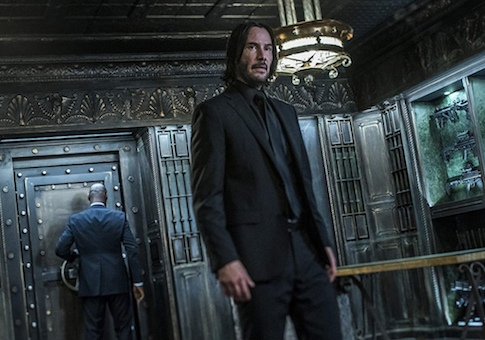One of my favorite action scenes in the history of cinema comes in an unlikely spot: about midway, maybe a little more, through Raising Arizona.
You might remember the moment. The dunderheaded H.I. (Nicolas Cage) is forced to fight a pair of bank robbers (John Goodman and William Forsythe) who have decided to kidnap the baby boy that H.I. and his wife Ed (Holly Hunter) have themselves kidnapped. H.I., displeased by this turn of events, puts up a fight in the cramped confines of the family's mobile home. What follows is a masterpiece of comic action: Goodman banging his head on a low-clearance light fixture; Cage screaming in pain after scraping his knuckles on the popcorn ceiling while he attempts a double ax-handle on Goodman; Goodman's elbow smashing through a window while he winds up for a punch that goes through a closet wall.
The Coens understood that what made this fight work for viewers was the cramped quarters, the lack of space: In this case, it was funny because it looked and felt real.
Similarly, I think a reason that the action scenes in the John Wick movies work is because Chad Stahelski has a keen understanding of space and how to use it effectively. You see this most clearly in the John Wick: Chapter 3's opening set piece. Picking up moments after John Wick: Chapter 2 ended—Wick (Keanu Reeves) has an escalating price on his head and his violation of the rules of The Continental means he is excommunicado, lacking the services provided by hotelier and assassin-whisperer Winston (Ian McShane)—Parabellum's first fight takes place in the stacks of a library.
Wick and an enormous Serbian goon (NBA player Boban Marjanovic) make the most of their cramped quarters, gaining leverage from bookshelves and using codices as cudgels while trying their hardest to kill each other. The whole thing is darkly funny—the packed audience with whom I saw the film escalated "oohs" every time a blow landed and giggled every time a stroke was thwarted by the confined space—and deeply entertaining, even if you know how it has to end. (Spoiler: John Wick wins.) It's a perfect tone-setting introduction: everything you're about to see is going to be both ridiculous yet strangely believable, from the knife fight in a gun shop to the utilization of war dogs by Sofia (Halle Berry) in an airy Moroccan courtyard to the final assault pitting Wick and Continental concierge Charon (Lance Reddick) against an army of body-armored thugs commanded by the High Table's Adjudicator (Asia Kate Dillon).
Adjudicators, High Table, Excommunicado: that's right, there's world building! We learn more about the world of assassins first introduced in John Wick, though sometimes this goes a bit overboard. It's not clear to me that we needed Berrada (Jerome Flynn) to explain to us that the gold coins are not a measure of value but an expression of the social contract, an exchange of favors that keeps the system running. The system itself might have used a bit more elucidation—there's the High Table and its emissary, the Adjudicator, but also a man above the high table whose power seems unlimited yet also does the work of the High Table—and one hopes that might be revealed in a future installment.
And there will be a future installment, and I will be there for it. Set aside the frenetic action and the cleverness of the kills: I'm fascinated by the moral universe explored in these three movies. John Wick was asking a basic enough question: does justice exist? Yes, the plot was so simple it could be explained in its entirety via haiku.* Yes, that simplicity itself is now an in-universe joke; everyone who meets Wick semi-mocks him with their surprise that he has torn down his whole world for the sake of a puppy and a car. But there's nothing simple about justice, or the traps we set for ourselves while pursuing it.
John Wick: Chapter Two, meanwhile, looked inward. It is about the self and whether or not change is truly possible. "Can a man like you know peace?" a Russian mobster asks Wick early on. Wick's naïve reply: "Why not?" Wick's problem is that peace would be a violation of his core: He is a killer. Strike that: He is the best killer. And when someone is the best at what they do, the system will find a way to coopt him regardless of what he wants. Which brings us to Chapter Three, an examination of the natural order and the futility of efforts aimed at upending it.
Wick is a modern exemplar of arete, the ancient Greek notion that excellence and virtue are one and the same. He thinks this virtue is enough to separate him from the killers with which he has spent the last three movies contending. This belief, in turn, is why he always denies being anything like those who are trying to stop him. Wick supposes his excellence is his path to freedom. His power—his mythical ability to kill anyone, anywhere, like The Bogeyman itself—is unique to his person. He is different from, say, Winston, a man who relies on the system and its rules for his power and privilege.
But Wick's excellence is also his prison. The system cannot let him go because he is too useful to it, and useful men will always have a place in the system … even if they don't want it.
*Man's pooch slain, car pinched
He springs vengeance on culprits:
Dog was dead wife's gift
